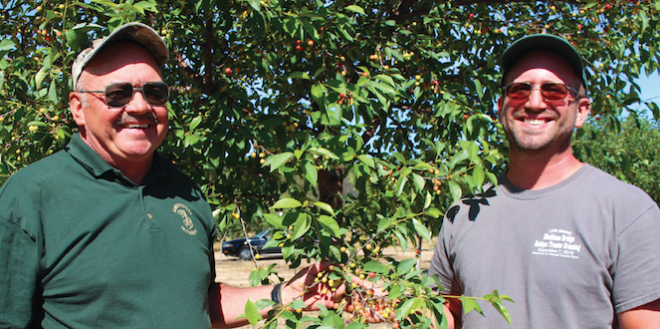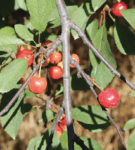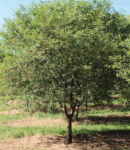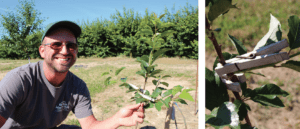

Jul 8, 2021Michigan cherry grower sees large crop in tough year
Late spring frosts took a bite out of the cherry harvest in much of Michigan, leaving many farms without any cherries at all.
Fennville, Michigan, tart cherry grower Hunsberger Farms was one of the fortunate operations, setting a voluminous crop that left Gary Hunsberger and his son, Justin, in position to analyze what might have led to their good fortune.
“Everything just did what it was supposed to do,” Gary said during a mid-June tour of their orchards. “All of this farming is a moving target. If you hit it just right, or do things just right, sometimes it comes out good and sometimes it doesn’t. This year, with the cold weather, the hit-and-miss warm days, we had a good warm day at the start of the bloom. We got cold for four or five days, and I said, ‘I don’t know about that.’
“And then, we had another warm day and the last 25-30% of the bloom came out,” he said. “We had another nice day for pollination. I said to Justin, ‘I think we could have a good crop of cherries.’ It was probably two or three weeks, what seemed like a long time in the shuck. It just stayed cold with freezing cold winds. For that kind of spring, I didn’t figure we would have anything. Then the weather started turning around, they started coming out of the shuck and things started to grow.
“I said, ‘Wow.’ This crop here is once in 30 years. We have a crop, and the state of Michigan does not have a crop. It’s once in a lifetime, but sometimes once in a lifetime doesn’t come to some people. We’re more than fortunate that we were able to get it in a year that’s going to be like this year, because we’re going to get paid something. I’m happy for where we’re at, what we’re doing. Everything lined up right. I’d like to see a little bit more rain coming in, but I’d like to keep the storms away.”


A growing legacy
Donald and Helen Hunsberger purchased the farm in 1954, a year before Gary was born. “And I haven’t left. Justin will be the third generation in the farming industry here.”
“I think grandpa was just a little crazy,” Justin Hunsberger said. “He lost part of his leg in World War II. For some reason, he wanted to be a farmer in Fennville. I don’t think I would have made that decision if I had lost a leg in a war.”
“They did hard things back then, years ago,” Gary Hunsberger recalled. “Now, they can’t run up to the line fast enough, but back then, everybody worked, and everybody had to work to get things going. We’ve lost the old time way that used to be what ran the country. Now, it’s turned around a complete 180 and it’s not that way anymore. I’m still old school and teaching Justin so he’s understanding why there’s work to do here. The labor is a little bit lean. We’re able to get enough hands to do things when we need to.”
“For 80-90% of the work, you’re looking at the workforce right here,” Justin said. “Either my dad or I do it. When we have harvest, or like when we have 1,000 trees to put in the ground, we get someone else to help with the shoveler, one to help with the forklift, or harvest. Eleven months out of the year, you’re looking at the crew.”
“We still do it the old-school way,” Gary said.
“We still mark the orchard out and use an auger to dig the holes,” Justin noted. “There’s still no GPS, just a three-point auger on an old Ford tractor, not like an auger on a Bobcat. Though, I do really want to get one eventually.”
With two nearly adjacent farm properties, the Hunsbergers own a total of 137 acres, 100 of which is in fruit production. Roughly 80-90 acres are in tart cherries. There are 10 acres of various European and Japanese-type plums.
“We usually do well with plums,” Gary said. “This year it was darned-near snow time. They were in bloom for two weeks and they never got pollinated. But the European Stanleys and Damson came out. We had good weather. They got pollinated and came out to a real good crop.”
Finding a local market


The farm grows Montmorency and Balaton cherries.
“We used to have 35-40 acres of Balaton. We sell them to Fenn Valley Winery, right here beside us. I started out with 1,000 trees, the second year they were commercially selling trees. I gave (Doug Welch, owner of Fenn Valley) 1,000 pounds of Balatons to start making wine. I said, ‘Here, take these and see what you can do. Try them out. If you don’t like them we’ll do something different.’ He took them to make cherry wine, and from then on, it just got crazy. He uses a tremendous amount of Balatons for the cherry wine industry, and also uses it in their cider.”
Several other nearby wineries and one brewery use the Balatons in their mixes.
Time in the sprayer seat
The cherries are susceptible to spotted wing drosophila.
“You have to spray for them. They’re just another pest that you have to stay up with. You have to keep sprayed up. You have to get off the harvester and spray the right chemicals ahead of the harvester to keep the fruit clean and to be able to sell them to the processor so they can do their thing on the back side.


“It’s a challenge all year,” Gary Hunsberger said. “You have to get on the sprayer in the spring and stay on it through harvest. After harvest you have to get some dormant sprays on. You have to stay pretty tight when they’re blooming and keep the brown rot out of the fruit. You have to keep the leaf spot off the trees. You have to stay up on things and use different chemicals at different times and stay away from using too much of the chemicals. There’s plenty of different chemicals out there and different modes of action to do things to get to where you’re at. This is an easier year because it’s drier so you don’t have rains washing things off.”
Justin Hunsberger said, “The dry conditions are not good for the trees themselves, but it’s pretty nice for the spray schedules. I think this dryness we had is part of what helped our crop set. Instead of having wet and cold. Even though it was cold, that dryness made it a lot easier on the trees to make them bloom and do more of what they’re supposed to do than the last two to three years where we’ve been counting the rains. It rained for weeks, it seemed like. It rained for basically two weeks.”
Credit the training system
The Hunsbergers plant their trees close together and prune hard to open the tree up. They use a unique split trunk training system that seems to work remarkably well.
“We’ll plant the tree. We’ll whip it, which is taking all of the branches off the tree,” Gary said. “Mike Thomas, my mentor many years ago, showed us how to use a clothespin to get a 90-degree angle on the young branches of the tree. You put the clothes pin on for 30 days. You take it off. During the 30 days, the grizzled part will turn into wood. By that time, you have a 90-degree angle on your crotches that come out of the trees.
“The next spring, you come back and take all of the other branches off the tree and leave the ones that you have the clothespin on to have those wider-angle crotches on the tree. You can grow the tree much faster and easier doing it that way. If you have some issues in year two, three or four, they’ve got spreaders that want to suck straight up. You want the tree to grow out in a bow.


“You (usually) don’t get a crop on the inside of the tree. You get it on the outside. So you want to trim the top middle and inside the tree to get light. You do get fruit buds and a crop inside the tree if you trim the tree and work the tree right. So, actually, you can get twice as many cherries out of one of my trees than someone else’s because you can make the tree crop more.”
“If you trim the trunk in the spring, you can get fruit all the way through, which is what you will see when you get out into the orchard,” Justin Hunsberger said. “That’s also why this crop is so big. It’s all of those small, little things – the trimming. It’s a half a percent here or there. It can just all add up to have the right year where there’s just a ton of fruit on the trees.”
“We have a crop from top to bottom, inside and out,” Gary said. “It’s normally hard to do that in a decent year. It’s nearly impossible to do it in a year like this year. All of the little small things that we’ve done to get where we’re at at this point in time got us off to the races.”
“With nobody having any kind of reasonable cherry crop, for us to have that many cherries out here is remarkable,” Justin said.
A matter of spacing
“Dad used to plant probably about 80 trees to the acre,” Gary said. “He believed that to have sunshine, you have to have a space around it. With these chemicals, you can spray 20 trees to the acre or 200 trees to the acre, it’s the same amount of chemicals per acre. All of those extra trees that you are putting into the acre are basically getting sprayed free. We’re getting probably around 120-140 trees to the acre the way we’re putting the trees in.
“I like to plant the trees on a diagonal. You’re able to get more trees into the acre. We’re still old-fashioned. We use an open-station tractor to get down through there and spray. So we’re tucking underneath the trees and working basically underneath the trees and spraying up, instead of going on the side of the tree and spraying in. We’re still using an old Case tractor to pull our sprayer.
RELATED: How Hunsberger Farms keeps cherry growing productive››
“One of the reasons why we do have a bigger crop is we use Gibberellic acid (a potent hormone whose natural occurrence in plants controls their development),” Gary said. “It promotes two things: one, on older trees, at one rate, you can make more fruit buds. On a younger tree, to grow it faster to get it into production, you use it at a different rate and it will take the fruit off for next year, so it will not bloom and it will grow faster as a young tree.
“With the older tree, you put the acid on the year before and it will promote more fruit buds, so you get a crop more like this. Everything worked out this year that we had more blooms to get better pollination, knocked the freeze off and the tree held them. We had some June drop. That’s some of the reasons besides the cultural practices that we do and use.”
The Hunsbergers paint their tree trunks white on the southwest side for the sun so they don’t crack the trunks of the trees. They tie the trees up so they don’t break down with a large crop.
“There’s a lot of things that we do that people do not see,” Gary said.
— Gary Pullano, editor














